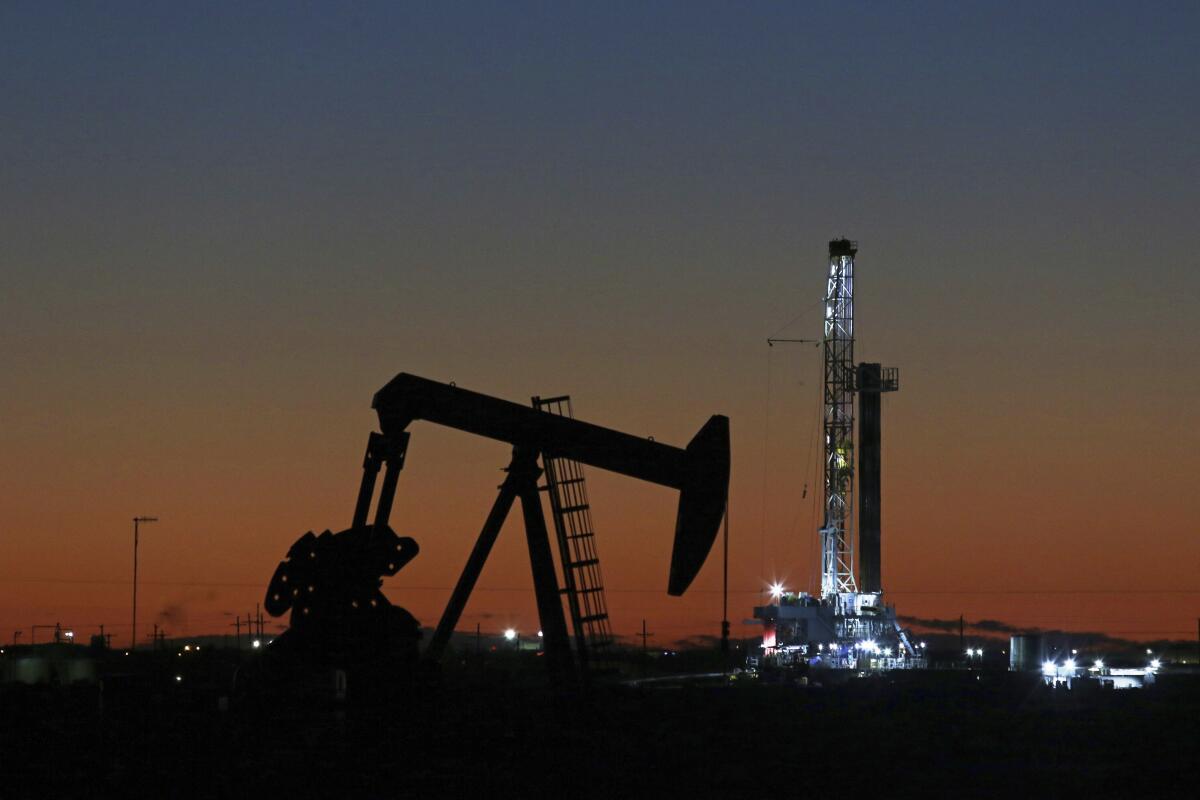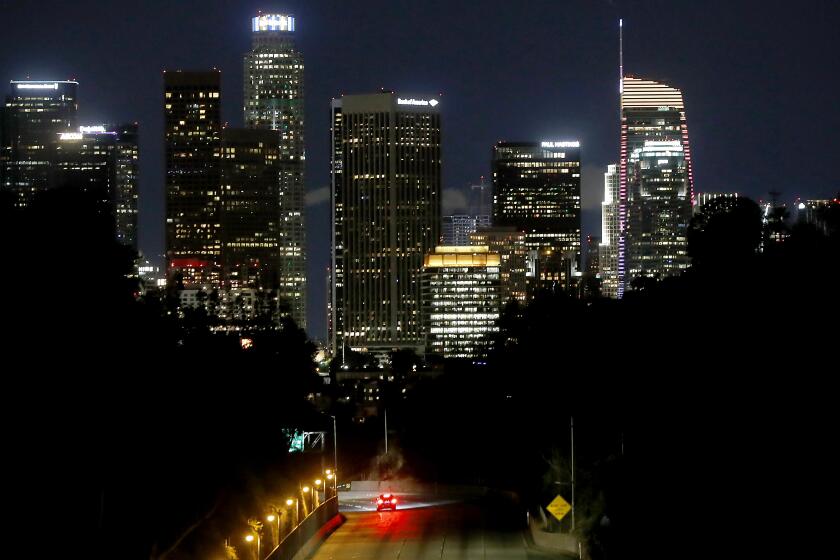Trump’s oil-production pact may do little to help U.S. producers or drivers amid coronavirus

- Share via
WASHINGTON — The agreement announced Sunday by Russia, Saudi Arabia and other oil-producing countries to cut back output is unlikely to raise fuel prices much for American consumers in the weeks and months ahead.
That should be good news for the American economy and for President Trump. But these are not normal times.
For the record:
9:43 a.m. April 21, 2020An earlier version of this article attributed comments by the energy research firm Kayrros to Antoine Rostand, the company’s president and founder. The comments were made by Antoine Halff, another Kayrros founder.
The coronavirus pandemic has created a painful bind for Trump and for the United States: Plunging oil prices, coupled with a huge glut in global oil inventories, are savaging the petroleum industry at a time when the U.S. has become the world’s largest oil producer.
Long before he was elected president and continuing after he entered the White House, Trump lambasted attempts by OPEC, the oil cartel, to prop up petroleum prices by limiting production.
With prices collapsing under the weight of an oil glut, negotiators struck a deal that aimed at restoring confidence before markets reopened.
That’s been a politically rewarding stance because lower oil prices are the equivalent of a tax cut for drivers, homeowners and many businesses: They put more spending money in people’s pockets and generate goodwill toward leaders who take the credit.
That has generally been true even if the decline hurt the U.S. oil industry.
But not so in the age of COVID-19. State and local governments have ordered lockdowns, stay-home orders and social distancing policies that experts say are necessary to reduce the pandemic’s toll.
“This is a fairly new situation,” said Antoine Halff, a founder of Kayrros, an energy research and consulting firm. “Those who could enjoy low prices are stuck at home,” he said, and U.S. oil producers are suffering the downside of depressed prices.
Gasoline prices are certainly falling. The national average for regular gas dropped to $1.92 per gallon in the week ending April 6, below $2 for the first time in more than four years and down 50 cents from just a month earlier. It’s dropped a similar amount in California to $2.87 a gallon.
Experts see fuel prices sliding further, possibly to record lows on an inflation-adjusted basis.
The new agreement to lower oil production is unlikely to have much effect at a time when the world is already awash in surplus oil and most major economies, including the U.S., are plunging into recession.
After the coronavirus pandemic cools down, how will California start getting back to normal? Slowly, methodically and in stages.
Analysts say the cutback, unprecedented as it was, is too little and too late.
The agreement by 23 oil-producing countries pledges to remove 9.7 million barrels of oil a day from world markets. But amid the pandemic, global demand for oil has fallen by at least 20 million barrels, some say as much as 30 million, a day.
Moreover, it’s not enough to erase the existing glut in oil inventories around the world anytime soon.
“Every available pipeline and storage terminal is about to be completely full, so you have to stop production or you’ve got to pay someone to take your production away,” said Bobby Tudor, chairman of Tudor, Pickering, Holt & Co., an investment banking firm based in Houston, the nation’s oil capital.
“If 16% of oil demand is people just driving to and from work globally, how quickly does that come back?” he asked. “How quickly will we all be willing to get back on an airplane?”
For Trump, the new reality has meant flip-flopping on his long-standing aversion to deals to reduce oil output.
Before the 2018 midterm elections, when the price of gasoline was rising to nearly $3 per gallon, Trump jawboned Saudi Arabia to boost its production to get prices down.
As recently as March 9, days before the spreading coronavirus drove Trump to embrace social distancing restrictions, he cheered a silver lining in the one-two punch of the pandemic and the Russia-Saudi price war.
“Good for the consumer, gasoline prices coming down,” the president tweeted.
But just two weeks later Trump tweeted that “Our great Oil & Gas industry” is under siege. And since then the president has reached out to Russia while U.S. lawmakers have pressured Saudi Arabia in no uncertain terms to halt their disastrous battle for market share.
Trump’s about-face comes as U.S. producers are indeed under siege.
Texas, North Dakota, Oklahoma, New Mexico and other oil-producing states are feeling the first waves of shutdowns and company bankruptcies. That is further aggravating the overall plunge in employment and economic activity nationwide.
Tudor said he is already seeing significant layoffs at Houston’s oil firms and spillover to ancillary businesses.
“A collapse to this industry would be a really bad thing ultimately, not just for Houston but for the broader economy in the country,” he said.
In the last month, there’s been a 50% reduction of crews working in America’s shale oil basins, according to an analysis of satellite images and other calculations by Kayrros.
“That’s really unprecedented,” said Kayrros’ Halff. “It really reflects the reality on the ground: that there’s a very dramatic imbalance between supply and demand.”
Things have gotten so worrisome in Texas, by far the nation’s leading oil producer, that state authorities are considering imposing production caps for the first time in a century.
In the face of falling demand and the existing supply glut, the new cutback agreement is not nearly large enough to reverse the situation anytime soon.
At the end of 2015, the world had 593 million barrels of surplus oil inventory. And with the global economy growing about 3.5%, it still took two years to work off the supplies, said Amy Myers Jaffe, senior fellow for energy and the environment at the Council on Foreign Relations.
The cutback deal Sunday may avert what Jaffe called a worst-case scenario in which oil stockpiles would fill up well above 2015 levels at a time when the world economy is in recession.
Still, she said, “Oil prices are bound to stay low.”
Certainly, the mismatch between supply and demand was exacerbated by the price war between Russia and Saudi Arabia, two of the biggest oil producers. They sought to gobble up a larger share of the oil market by producing more and swallowing the resulting price declines.
The combination of the coronavirus and the Saudi-Russia feud saw the U.S. benchmark price of crude tumble from more than $61 a barrel at the start of the year to a low of $19.27 on March 30. Despite the agreement, it was down 1.5% on Monday to $22.41 a barrel.
That price is barely half of the break-even level for many producers in the United States, and so companies have begun to reduce the flow.
Giant oil firms, such as Chevron and Exxon, are in relatively good financial shape to weather the downturn. In addition to size, those producing shale oil will be better off. Shale beds can be turned off and on with less risk of damage compared with conventional wells.
A lot of smaller and independent drillers, however, could fold or be eaten up by larger firms. And this time, investors won’t be running back to the oil industry to supply capital as in the past. Not only have they been repeatedly burned by disappointing performance, now they see a very uncertain outlook.
As both the biggest producer and the biggest user of oil, accounting for about 20% of the 100 million barrels a day consumed worldwide, the U.S. is taking hits on both sides of the equation.
Daniel Yergin, the energy expert who is vice chairman of IHS Markit, a research and consulting firm, wrote recently that U.S. production could drop by almost 3 million barrels per day by year’s end. That could knock the U.S. below the Saudis and Russians as the top producer. It could also mean rising oil imports.
“The economic costs will be high, given the importance of the shale revolution to the overall U.S. economy — accounting altogether, according to analysis by IHS Markit, for about 2.5 million jobs,” Yergin said in an article in Foreign Affairs.
More to Read
Get the L.A. Times Politics newsletter
Deeply reported insights into legislation, politics and policy from Sacramento, Washington and beyond. In your inbox three times per week.
You may occasionally receive promotional content from the Los Angeles Times.












